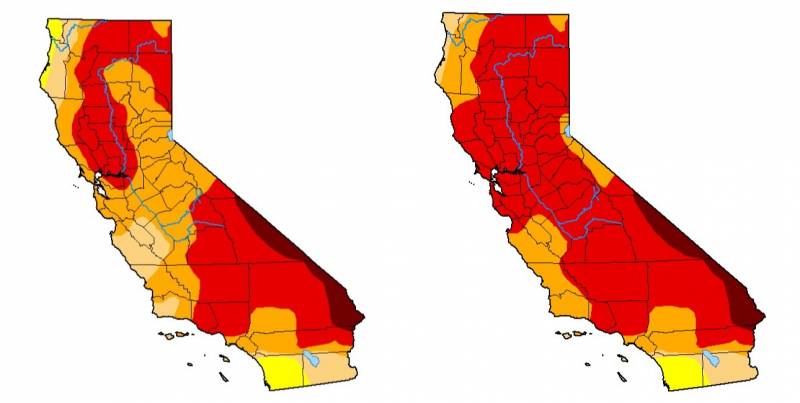On Monday, Gov. Gavin Newsom expanded the drought emergency he declared on April 21 to an additional 39 counties, widening the official order to 41 counties representing 30% of the state’s population. In the Bay Area, Contra Costa, Napa, Solano and Sonoma counties are now covered by the declaration.
The Entire Bay Area Is in Extreme Drought. Here's What Your Local Water Supplier Is Doing

Over the last couple of weeks, the entire Bay Area, has jumped from moderate to extreme drought conditions, according to the U.S. Drought Monitor. But what that means for residents across the region depends on where you live.
Back-to-back dry years, above normal temperatures, and a below normal snowpack are reminiscent of the last multiyear drought, ending in 2017, says Napa Deputy Utilities Director Joy Eldredge. But she thinks this time might be worse.
“I’m less comfortable than I’ve been for the past 15 years in this position, I’ll put it that way,” she said of her assessment of what lies ahead.
The city of Napa has asked residents to voluntarily cut 15% of their water use. Sonoma County is asking for 20%, and Grant Davis, general manager for Sonoma Water, says he’ll be asking the state to reduce flows along the Russian River by 20% to conserve water in Lake Sonoma and Lake Mendocino.
“The Russian River watershed [has] the lowest water levels we’ve seen in our two reservoirs at this time of year, ever,” Davis said.
The continuing dry conditions could lead to a 75% decrease in water deliveries to Sonoma County communities in the upper watershed this summer. Sonoma and Mendocino counties were the two areas covered by Newsom’s original drought declaration.
Water officials say they are waiting for statewide water restrictions to be issued,
“(I)f we do not see a 20% reduction, then we will likely move into a mandatory conservation situation, probably on July 1,” Davis said.
Mandatory in Marin
Marin Water is the only agency in the Bay Area mandating that residents cut water use. Officials are aiming for a 40% reduction.
“This drought is tracking really to become a drought of record,” said Marin Water spokesperson Jeanne Belding. “Our rainfall levels over the past 16 months have been the lowest that we’ve seen in more than 140 years.”
The new water rules in Marin include limiting spray irrigation to two days per week; a restriction on outdoor water use like watering gardens or grass from 9 a.m. to 7 p.m.; and shutting down decorative fountains.
“Water is so ubiquitous, you turn on the tap, and it’s there,” Belding said. “We have to realize that it’s a limited resource. So, doing everything that you can to conserve is going to be critical.”
For the rest of the Bay Area, the situation is a little more complicated. Water districts don’t follow county lines, and they have very different water sources, including groundwater, rainfall, reservoirs, and snowmelt from the Sierra Nevada. Most districts are asking people to play their part voluntarily.
The San Francisco Public Utilities Commission isn’t asking residents to conserve a defined percentage of water, but it wants people to do what they can.
“At the moment, we’re in pretty decent shape,” said Will Reisman, spokesperson for the SFPUC, who said the city’s water supply was not drastically lagging historical levels. “We are a little under 77% of our maximum storage capacity at our reservoirs. Typically at this time of year we’re a little under 82%.”
But Reisman says the agency is asking its 1,600 irrigation customers — think parks and golf courses — to cut 10%. San Francisco also sells a lot of water to its neighbors, and the SFPUC has asked them to use less than they did before the pandemic began in 2019. He says water usage has begun to increase after it dropped during the various stay-at-home orders imposed during the pandemic.
“We recognize that this creates some confusion,” said Nicole Sandkulla, CEO of the Bay Area Water Supply & Conservation Agency. “This is all developing kind of as we speak. So we don’t have the best answer yet.”
Sandkulla’s agency helps supply water, primarily from San Francisco via the Hetch Hetchy Reservoir in Yosemite National Park, to 26 agencies within San Mateo, Santa Clara and Alameda counties.
Considering the scale of this drought, she says that even if residents live in an area with no water restrictions, it’s time to start cutting back on daily activities like watering lawns and doing laundry. Sandkulla herself had planned to plant roses this spring.
“But nope, I’m not going to do that,” she said. “Maybe now is not the time to be replanting with something that’s going to require more water.”
She says if everyone cuts back in little ways, the Bay Area could avoid the worst consequences of the drought.
But is there any hope for significant rain this summer? The short answer is no, says Brian Garcia, a warning coordination meteorologist with the National Weather Service San Francisco Bay Area.
When looking at precipitation prospects for the city of San Francisco, “the likelihood of recovery between now and the end of the water year: 0%,” Garcia said.
He says climate models show a much better shot of atmospheric rivers forming next winter, hopefully pelting the state with snow and rain. These massive, fast-moving storm systems normally account for about half of the state’s annual precipitation, but this winter the Bay Area got soaked by only one.
“Just a crystal ball look, but it looks like a better winter precipitation-wise,” he said.